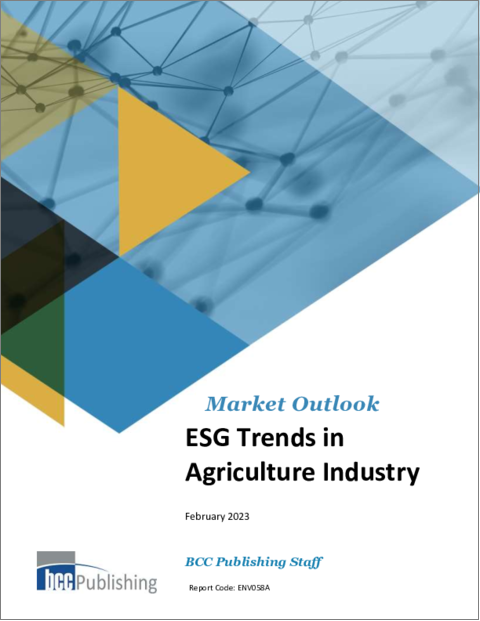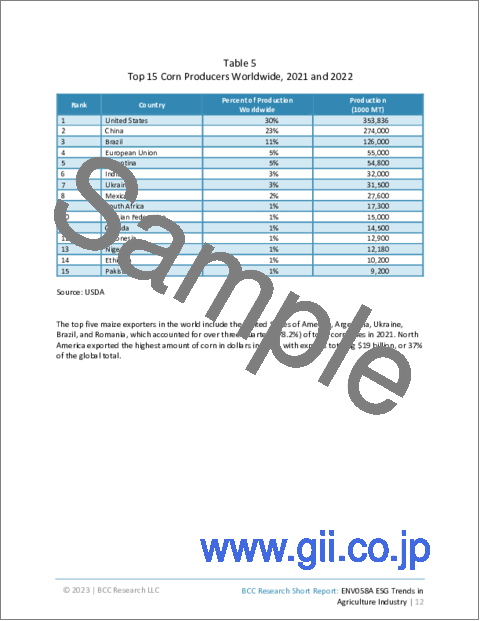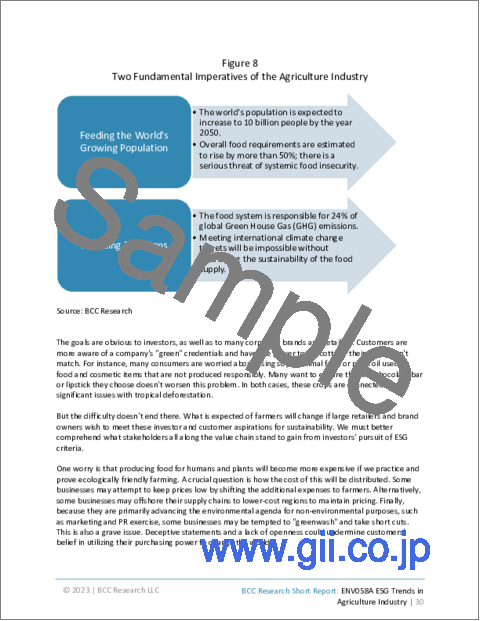|
|
市場調査レポート
商品コード
1180595
農業におけるESGの動向ESG Trends in Agriculture Industry |
||||||
| 農業におけるESGの動向 |
|
出版日: 2023年01月02日
発行: BCC Research
ページ情報: 英文 55 Pages
納期: 即納可能
|
- 全表示
- 概要
- 図表
- 目次
当レポートでは、農業におけるESGの動向を調査し、農業の現況、ESGコンプライアンスに向けた農業のアプローチ、ESGファクターに関する最近の動向と進歩の概要、ESGの実施に関連する成長機会と課題、ケーススタディ、ESGの持続可能性へのステップ、農業の将来に向けた提言などをまとめています。
目次
第1章 イントロダクション
第2章 農業の概要
- 世界の農業生産と貿易
- 世界の小麦貿易
- 世界のトウモロコシ貿易
- 世界の大麦貿易
- 世界のヒマワリ貿易
- ロシア・ウクライナ戦争の概要
- 食糧供給不足の影響
- 食品産業に対するロシア・ウクライナ戦争の影響
- 世界の農業生産におけるロシアとウクライナのシェア
第3章 農業におけるESGの動向
- 概要
- ESGの採用の増加
- 5つの重要なESG提案
- トップラインの成長
- コスト削減
- 法的および規制上の介入の削減
- 従業員の生産性の向上
- 資産と投資の最適化
- ESGコンプライアンスに向けた農業のアプローチ
第4章 重大な環境リスク
- 総排出量が最も多い4つの国
- ESGのファクター・重み付け・KPI
- 温室効果ガスの排出
- 大気汚染・水質汚染
- 土地・水利用への影響
第5章 重大な社会的リスク
- ESGの社会的要素
- 公衆安全
- 労働条件
- コミュニティ
第6章 農業とガバナンス
- 食料安全保障と栄養を実現する責任
- 国の責任
- 政府間組織および地域組織の責任
- 金融機関、寄付者、財団、基金
- 研究機関、大学、学外機関
- 小規模農家・組織
- 農家を含む企業
- 市民社会団体
- 労働者とその組織
第7章 ESGのレポーティングと格付け
- 概要
- ESG格付けの読み方
- ケーススタディ
第8章 ESGの持続可能性へのステップ
- ESG目標のための農業の改善
- 環境制御農業
- 農業バイオテクノロジー
- 精密農業技術
- 作物育種の改善
- 稲作の改善
- 食品廃棄物の削減
- パッケージの革新とコーティング
- アップサイクル食品
- 腸内発酵の提言
- 再生農業の実践
第9章 付録:頭字語
List of Tables
- Table 1 : Primary Agricultural Food Producing Countries
- Table 2 : Top 15 Wheat Producers Worldwide, 2021 and 2022
- Table 3 : Primary Wheat Exporting Countries Worldwide, 2021 and 2022
- Table 4 : Top 5 Wheat Importing Countries Worldwide, 2021
- Table 5 : Top 15 Corn Producers Worldwide, 2021 and 2022
- Table 6 : Primary Corn Exporting Countries Worldwide, 2021 and 2022
- Table 7 : Top 5 Corn Importing Countries Worldwide, 2021
- Table 8 : Top 15 Barley Producers Worldwide, 2021 and 2022
- Table 9 : Primary Barley Exporting Countries Worldwide, 2021 and 2022
- Table 10 : Primary Barley Importing Countries Worldwide, 2021 and 2022
- Table 11 : Top 10 Sunflower Seed Producers Worldwide, 2021 and 2022
- Table 12 : Primary Sunflower Oil Crude Producing Countries Worldwide, 2021 and 2022
- Table 13 : Top 5 Exporters of Sunflower Seed or Safflower Oil, Crude, 2020
- Table 14 : Environmental, Social, and Governance Standards
- Table 15 : Acronyms Used in This Report
List of Figures
- Figure 1 : Current and Projected Global Population ('1000)
- Figure 2 : Analysis of the Impact of the Russia-Ukraine War
- Figure 3 : Russia and Ukraine Shares of Global Agricultural Production, 2016-2017/2020-2021
- Figure 4 : Russia and Ukraine Shares of Global Agricultural Production, 2016-2017/2020-2021
- Figure 5 : ESG Adoption Level Across All Industries
- Figure 6 : ESG Adoption Level, by Region, Across All Industries
- Figure 7 : Five Critical ESG Propositions
- Figure 8 : Two Fundamental Imperatives of the Agriculture Industry
- Figure 9 : Publicly Available ESG Funds, 2008-2021
- Figure 10 : Material Environmental Risks across Their Value Chain
- Figure 11 : Factors, Weightage, Key Performance Indicators in ESG
- Figure 12 : Material Social Risks
- Figure 13 : Factors, Weightage, Key Performance Indicators in ESG
- Figure 14 : States' Key Roles
- Figure 15 : Steps in ESG
- Figure 16 : Steps to Understanding ESG Ratings
- Figure 17 : Sample Screenshot of Norofert ESG Rating
- Figure 18 : Sample Screenshot of Norofert Material ESG Issues
- Figure 19 : Future Outlook of the Agriculture Industry
- Figure 20 : Enhanced Farming Practices
Highlights:
The report provides an overview with the background knowledge needed while implementing ESG to support decision-makers in the agriculture industry. This report also examines how these trends may affect the agriculture industry in both short and long term. The report focuses on the evolving trends, market constraints, drivers, and opportunities likely to stimulate the agricultural sector's ESG investment.
Report Scope:
The report will provide an overview about the global agriculture industry through ESG perspective. Qualitative insights on ESG trends and its impact on agriculture companies are provided. The detail analysis of agriculture industry supply chain with respect to ESG is provided in the report. The detailed analysis of regulation for agriculture industry is given in the report. Further, it explains the major drivers, retains as well as trends impacting ESG implementation across agriculture industry.
Report Includes:
- An overview of the recent trends and advancements with respect to ESG (Environmental, Social, and Governance) factors in the agriculture industry
- Technology assessment of the market growth opportunities and challenges pertaining to the ESG implementation in agriculture stakeholders and other industry participants
- Review of ESG-related case studies and a detailed qualitative analysis of the global agriculture industry
- A look at the steps taken towards the ESG sustainability and recommendations for the future of the agriculture industry
- Emphasis on the ESG standards, stringent regulatory guidelines, historical trends and analysis, players offering ESG services, and market outlook of ESG services for the agriculture industry
- Market share analysis of major stakeholders operating in the marketplace, their business strategies, product mapping, and operational integration
Table of Contents
Chapter 1 Introduction
- 1.1 Study Goals and Objectives
- 1.2 Reasons for Doing This Study
- 1.3 Scope of Report
- 1.4 Intended Audience
- 1.5 Information Sources
- 1.6 Analyst's Credentials
- 1.7 BCC Custom Research
- 1.8 Related BCC Research Reports
Chapter 2 Overview of the Agriculture Industry
- 2.1 Introduction
- 2.2 Global Agriculture Production and Trade
- 2.2.1 Global Wheat Trade
- 2.2.2 Global Corn Trade
- 2.2.3 Global Barley Trade
- 2.2.4 Global Sunflower Trade
- 2.2.5 Overview of the Russia-Ukraine War
- 2.2.6 Impact of Food Supply Shortage
- 2.2.7 Consequences of the Russia-Ukraine War on the Food Industry
- 2.3 Russia and Ukraine's Share of Global Agricultural Production
Chapter 3 ESG Trends in the Agriculture Industry
- 3.1 Overview
- 3.2 Increasing Adoption of ESG
- 3.3 Five Critical ESG Propositions
- 3.3.1 Top-Line Growth
- 3.3.2 Cost Savings
- 3.3.3 Reduced Legal and Regulatory Interventions
- 3.3.4 Increased Employee Productivity
- 3.3.5 Asset and Investment Optimization
- 3.4 Agriculture Industry's Approach toward ESG Compliance
Chapter 4 Material Environmental Risks
- 4.1 The Four Nations with the Highest Overall Production of Emissions
- 4.2 Factors, Weightage, Key Performance Indicators in ESG
- 4.2.1 Greenhouse Gas Emissions
- 4.2.2 Air and Water Pollution
- 4.2.3 Land and Water Use Impacts
Chapter 5 Material Social Risks
- 5.1 Social Components of ESG
- 5.1.1 Public Safety
- 5.1.2 Working Conditions
- 5.1.3 Communities
Chapter 6 Agriculture Industry and Governance
- 6.1 Bearing the Responsibility for Achieving Food Security and Nutrition
- 6.1.1 States' Responsibilities
- 6.1.2 Intergovernmental and Regional Organizations Responsibilities
- 6.1.3 Financing Institutions, Donors, Foundations, and Funds
- 6.1.4 Research Organizations, Universities, and Extension Organizations
- 6.1.5 Smallholders and Their Organizations
- 6.1.6 Business Enterprises, including Farmers
- 6.1.7 Civil Society Organizations
- 6.1.8 Workers and Their Organizations
Chapter 7 ESG Reporting and Rating
- 7.1 Overview
- 7.2 How to Read ESG Ratings
- 7.3 Case Study
Chapter 8 Steps toward ESG Sustainability
- 8.1 Enhanced Farming Practices for ESG Goals
- 8.1.1 Controlled Environment Agriculture
- 8.1.2 Agricultural Biotech
- 8.1.3 Precision Agriculture Technologies
- 8.1.4 Improving Crop Breeding
- 8.1.5 Improving Rice Cultivation
- 8.1.6 Decreasing Food Waste
- 8.1.7 Packaging Innovation and Coatings
- 8.1.8 Upcycled Foods
- 8.1.9 Reducing Enteric Fermentation
- 8.1.10 Regenerative Agriculture Practices




